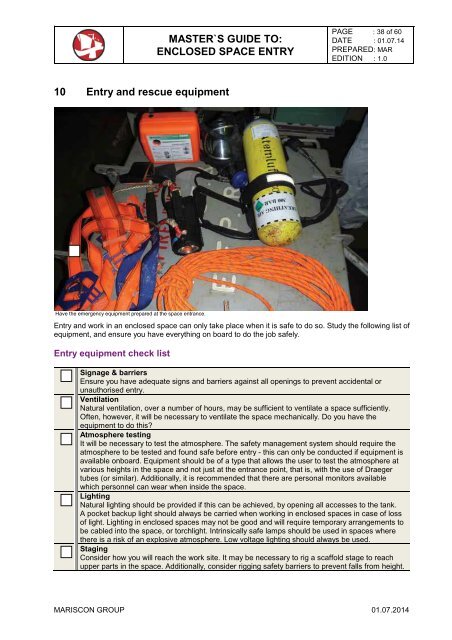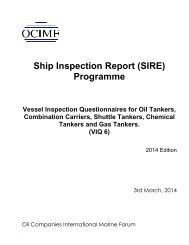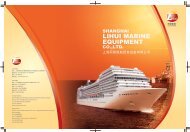MASTER`S GUIDE TO: ENCLOSED SPACE ENTRY
Create successful ePaper yourself
Turn your PDF publications into a flip-book with our unique Google optimized e-Paper software.
<strong>MASTER`S</strong> <strong>GUIDE</strong> <strong>TO</strong>:<br />
<strong>ENCLOSED</strong> <strong>SPACE</strong> <strong>ENTRY</strong><br />
PAGE : 38 of 60<br />
DATE : 01.07.14<br />
PREPARED: MAR<br />
EDITION : 1.0<br />
10 Entry and rescue equipment<br />
Have the emergency equipment prepared at the space entrance.<br />
Entry and work in an enclosed space can only take place when it is safe to do so. Study the following list of<br />
equipment, and ensure you have everything on board to do the job safely.<br />
Entry equipment check list<br />
Signage & barriers<br />
Ensure you have adequate signs and barriers against all openings to prevent accidental or<br />
unauthorised entry.<br />
Ventilation<br />
Natural ventilation, over a number of hours, may be sufficient to ventilate a space sufficiently.<br />
Often, however, it will be necessary to ventilate the space mechanically. Do you have the<br />
equipment to do this?<br />
Atmosphere testing<br />
It will be necessary to test the atmosphere. The safety management system should require the<br />
atmosphere to be tested and found safe before entry - this can only be conducted if equipment is<br />
available onboard. Equipment should be of a type that allows the user to test the atmosphere at<br />
various heights in the space and not just at the entrance point, that is, with the use of Draeger<br />
tubes (or similar). Additionally, it is recommended that there are personal monitors available<br />
which personnel can wear when inside the space.<br />
Lighting<br />
Natural lighting should be provided if this can be achieved, by opening all accesses to the tank.<br />
A pocket backup light should always be carried when working in enclosed spaces in case of loss<br />
of light. Lighting in enclosed spaces may not be good and will require temporary arrangements to<br />
be cabled into the space, or torchlight. Intrinsically safe lamps should be used in spaces where<br />
there is a risk of an explosive atmosphere. Low voltage lighting should always be used.<br />
Staging<br />
Consider how you will reach the work site. It may be necessary to rig a scaffold stage to reach<br />
upper parts in the space. Additionally, consider rigging safety barriers to prevent falls from height.<br />
MARISCON GROUP 01.07.2014














